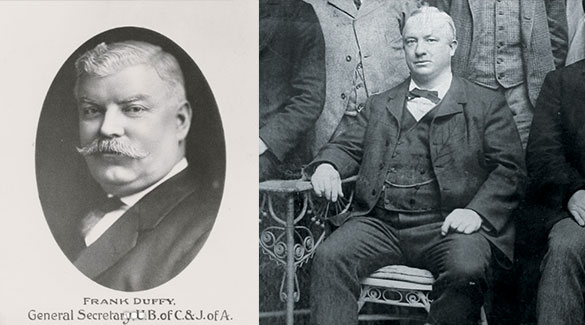The story of how the UBC was named shows why our founders persisted in creating just one union for all working carpenters.

UBC Founder Peter J. McGuire, at right, traveled extensively to organize carpenters and served as general secretary from 1881 to 1902. Succeeding him was Frank Duffy, who served until 1948.
The UBC celebrated its 50th anniversary in 1931 and published historical information in the July edition of The Carpenter that year.
Here are excerpts from “Our Organization,” an article written by General Secretary Frank Duffy, who had succeeded founder P.J. McGuire.
“The Brotherhood of Carpenters and Joiners of America was organized in convention held in Chicago, Illinois, from August 8 – 12, 1881. It was a question at that time whether or not it would be a success as several attempts had been made previously…but without success.
“The cities represented were: St. Louis, Kansas City, Buffalo, New York, Cleveland, Cincinnati, Detroit, Philadelphia, Chicago, Washington DC and Indianapolis.”
[Duffy described the difficulties carpenters faced at the time that 46 delegates representing about 2,000 carpenters met to form a union:]
“[W]orking long hours for poor wages under unsatisfactory conditions
“The subdivisions of the trade, bringing with it specialization, lessened the demand for skilled labor….
“…no apprenticeship system or method of training for those who wanted to follow the trade, and this did not help matters with men who spent several years of their youth to learn the trade in all its branches.
“The introduction of machinery in the industry, throwing men out of work, was another cause for discontent.
“The piece work system took the place of the day work system and this caused more complaint and dissatisfaction.
“At that time competition was keen. Cheapness was the rule. Quality did not count; quantity was wanted. A big day’s work at as small a wage as possible was demanded. And so things went from bad to worse until they became practically unbearable. Was it any wonder then that the delegates…were determined to organize an International Union?”
[Led by McGuire, founders of the new union worked together to organize carpenters. The next ten years were difficult, but the Brotherhood resolved to bring all carpentry crafts together.]
“In New York City and vicinity there existed what was then looked upon as a powerful and aggressive organization known as “The United Order of American Carpenters and Joiners,” with a membership of 5,000.”
[The New York organization had been organized several years before the Brotherhood and resisted UBC officers’ urgent efforts to affiliate. Duffy himself had been a leader of the United Order.]
“While they admitted there should be only one organization of the craft, they wanted to retain their own name, or at least part of it. On this hinged the question of their affiliation.
“However, at the Detroit, Michigan, convention in 1888 a plan of consolidation was reached which included a change in the name of the organization. It was proposed that the word “United” be placed before the word “Brotherhood,” making the name “The United Brotherhood of Carpenters and Joiners of America.” This gave general satisfaction to all…and that is how we got our name…”
[Duffy listed several organizations that became part of the UBC between 1890 and 1924:]
[These affiliations finally brought recognition of the UBC as the sole organization in the woodworking industry by the American Federation of Labor.]
“The progress of the organization has been onward and forward, ever aiming for greater and nobler things. The growth of the movement has been of a steady continuous character indicating that its founders built both wisely and well and that their successors followed closely in their footsteps.”